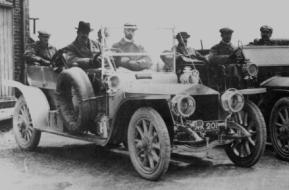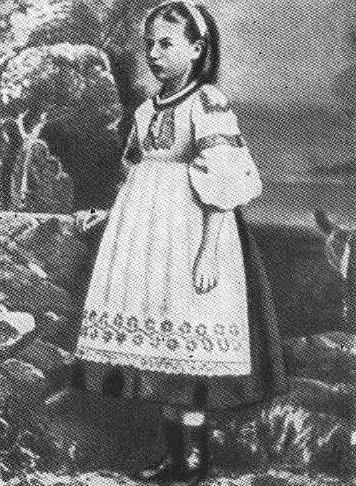|
Gorki Leninskiye
Gorki Leninskiye (russian: Го́рки Ле́нинские) is an urban locality (a work settlement) in Leninsky District of Moscow Oblast, Russia, located south of Moscow city limits and the Moscow Ring Road. Its population is: The estate of Gorki belonged to various Muscovite noblemen from the 18th century. Zinaida Morozova, the widow of Savva Morozov, purchased it in 1909, the year before she married General Anatoly Reinbot (later Anatoly Rezvoy), the chief of Moscow police. She engaged the most fashionable Russian architect, Fyodor Schechtel, to remodel the mansion in the then-current Neoclassical style, complete with a six-column Ionic portico. On 21 January 1924 Vladimir Lenin, the Communist Party leader of the Soviet Union since 1917, died there. Lenin's dacha After the Soviet government moved to Moscow in 1918, it nationalized the luxurious estate and converted it into Vladimir Lenin's dacha. In September 1918, the Soviet leader recuperated there following an ... [...More Info...] [...Related Items...] OR: [Wikipedia] [Google] [Baidu] |
Moscow Oblast
Moscow Oblast ( rus, Моско́вская о́бласть, r=Moskovskaya oblast', p=mɐˈskofskəjə ˈobləsʲtʲ), or Podmoskovye ( rus, Подмоско́вье, p=pədmɐˈskovʲjə, literally " under Moscow"), is a federal subject of Russia (an oblast). With a population of 7,095,120 ( 2010 Census) living in an area of , it is one of the most densely populated regions in the country and is the second most populous federal subject. The oblast has no official administrative center; its public authorities are located in Moscow and Krasnogorsk (Moscow Oblast Duma and government), and also across other locations in the oblast.According to Article 24 of the Charter of Moscow Oblast, the government bodies of the oblast are located in the city of Moscow and throughout the territory of Moscow Oblast. However, Moscow is not named the official administrative center of the oblast. Located in European Russia between latitudes 54° and 57° N and longitudes 35° and 41° ... [...More Info...] [...Related Items...] OR: [Wikipedia] [Google] [Baidu] |
Stamp Of USSR 1812
Stamp or Stamps or Stamping may refer to: Official documents and related impressions * Postage stamp, used to indicate prepayment of fees for public mail * Ration stamp, indicating the right to rationed goods * Revenue stamp, used on documents to indicate payment of tax * Rubber stamp, device used to apply inked markings to objects ** Passport stamp, a rubber stamp inked impression received in one's passport upon entering or exiting a country ** National Park Passport Stamps * Food stamps, tickets used in the United States that indicate the right to benefits in the Supplemental Nutrition Assistance Program Collectibles * Trading stamp, a small paper stamp given to customers by merchants in loyalty programs that predate the modern loyalty card * Eki stamp, a free collectible rubber ink stamp found at many train stations in Japan Places * Stamp Creek, a stream in Georgia * Stamps, Arkansas People * Stamp or Apiwat Ueathavornsuk (born 1982), Thai singer-songwriter * Stamp (surname ... [...More Info...] [...Related Items...] OR: [Wikipedia] [Google] [Baidu] |
Museums In Moscow Oblast
A museum ( ; plural museums or, rarely, musea) is a building or institution that cares for and displays a collection of artifacts and other objects of artistic, cultural, historical, or scientific importance. Many public museums make these items available for public viewing through exhibits that may be permanent or temporary. The largest museums are located in major cities throughout the world, while thousands of local museums exist in smaller cities, towns, and rural areas. Museums have varying aims, ranging from the conservation and documentation of their collection, serving researchers and specialists, to catering to the general public. The goal of serving researchers is not only scientific, but intended to serve the general public. There are many types of museums, including art museums, natural history museums, science museums, war museums, and children's museums. According to the International Council of Museums (ICOM), there are more than 55,000 museums in 202 countrie ... [...More Info...] [...Related Items...] OR: [Wikipedia] [Google] [Baidu] |
List Of Places Named After Vladimir Lenin
This is a list of places which are named or renamed after Vladimir Ilyich Ulyanov, better known by his alias Lenin. Some or all of the locations in former Soviet republics and satellites were renamed (frequently reverting to pre-Soviet names) after the fall of the Soviet Union, while Russia and aligned countries (mainly Belarus) retained the names of the thousands of streets, avenues, squares, regions, towns, and cities that were given Lenin's name as part of his cult of personality. Cities, towns, settlements and districts Former Soviet Union Azerbaijan *Ilyich (1924–1990) — Şərur, Nakhchivan Autonomous Republic *Lenin, Leninkend, and Leninfeld — Çinarlı, Shamkir *Leninabad — Kərimbəyli, Babek *Leninabad — Yeni yol, Shamkir *Leninabad — Sanqalan *Leninabad — Təklə, Gobustan *Leninavan — Həsənqaya, Tartar *Leninkənd — Qarakeçdi *Leninkend — Mustafabəyli *Port-İliç — Lankaran Rayon, now called Liman *Pamyat' Lenina — Balıqçılar ... [...More Info...] [...Related Items...] OR: [Wikipedia] [Google] [Baidu] |
Rolls-Royce Silver Ghost Kégresse
Rolls-Royce (always hyphenated) may refer to: * Rolls-Royce Limited, a British manufacturer of cars and later aero engines, founded in 1906, now defunct Automobiles * Rolls-Royce Motor Cars, the current car manufacturing company incorporated in 1998, a subsidiary of BMW Group * Rolls-Royce Motors, owner of the former car division incorporated in 1973, bought by Vickers in 1980, a subsidiary of Volkswagen Group from 1998 to 2002 * List of Rolls-Royce motor cars Aerospace and nuclear power * Rolls-Royce Holdings plc, an aerospace, power systems and defence company and Rolls-Royce's current principal operating company **Rolls-Royce Deutschland ***Rolls-Royce Power Systems ** Rolls-Royce Marine Power Operations ** Rolls-Royce North America ** Rolls-Royce Turbomeca ** Rolls-Royce Kamawea, now Kamewa ** Rolls-Royce Controls and Data Services See also * Rose Royce, an American soul and R&B group * Roll (other) * Royce (other) Markus Bennett is an American hip-hop r ... [...More Info...] [...Related Items...] OR: [Wikipedia] [Google] [Baidu] |
Rolls-Royce Silver Ghost
The Rolls-Royce Silver Ghost name refers both to a car model and one specific car from that series. Originally named the " 40/50 h.p." the chassis was first made at Royce's Manchester works, with production moving to Derby in July 1908, and also, between 1921 and 1926, in Springfield, Massachusetts. Chassis no. 60551, registered AX 201, was the car that was originally given the name "Silver Ghost." Other 40/50 hp cars were also given names, but the Silver Ghost title was taken up by the press, and soon all 40/50s were called by the name, a fact not officially recognised by Rolls-Royce until 1925, when the Phantom range was launched. The Silver Ghost was the origin of Rolls-Royce's claim of making the "best car in the world" – a phrase coined not by themselves, but by the prestigious publication '' Autocar'' in 1907. The chassis and engine were also used as the basis of a range of Rolls-Royce Armoured Cars. History In 1906, Rolls-Royce produced four chassis to b ... [...More Info...] [...Related Items...] OR: [Wikipedia] [Google] [Baidu] |
Nadezhda Krupskaya
Nadezhda Konstantinovna Krupskaya ( rus, links=no, Надежда Константиновна Крупская, p=nɐˈdʲeʐdə kənstɐnˈtʲinəvnə ˈkrupskəjə; 27 February 1939) was a Russian revolutionary and the wife of Vladimir Lenin. Krupskaya was born in Saint Petersburg to an aristocratic family that had descended into poverty, and she developed strong views about improving the lives of the poor. She embraced Marxism and met Lenin at a Marxist discussion group in 1894. Both were arrested in 1896 for revolutionary activities and after Lenin was exiled to Siberia, Krupskaya was allowed to join him in 1898 on the condition that they marry. The two settled in Munich and then London after their exile, before briefly returning to Russia to take part in the failed Revolution of 1905. Following the 1917 Revolution, Krupskaya was at the forefront of the political scene, becoming a member of the Communist Party's Central Committee in 1924. From 1922 to 1925, she was alig ... [...More Info...] [...Related Items...] OR: [Wikipedia] [Google] [Baidu] |
Lenin's Testament
Lenin's Testament is a document dictated by Vladimir Lenin in late 1922 and early 1923. In the testament, Lenin proposed changes to the structure of the Soviet governing bodies. Sensing his impending death, he also gave criticism of Bolshevik leaders Zinoviev, Kamenev, Trotsky, Bukharin, Pyatakov and Stalin. He warned of the possibility of a split developing in the party leadership between Trotsky and Stalin if proper measures were not taken to prevent it. In a post-script he also suggested Joseph Stalin be removed from his position as General Secretary of the Russian Communist Party's Central Committee. Document history Lenin wanted the testament to be read out at the 12th Party Congress of the Communist Party of the Soviet Union, to be held in April 1923. The document was originally dictated to Lenin's personal secretary, Lydia Fotiyeva. However, after Lenin's third stroke in March 1923 that left him paralyzed and unable to speak, the testament was kept secret by his wife, ... [...More Info...] [...Related Items...] OR: [Wikipedia] [Google] [Baidu] |
Moscow Kremlin
The Kremlin ( rus, Московский Кремль, r=Moskovskiy Kreml', p=ˈmɐˈskofskʲɪj krʲemlʲ, t=Moscow Kremlin) is a fortified complex in the center of Moscow founded by the Rurik dynasty. It is the best known of the kremlins (Russian citadels), and includes five palaces, four cathedrals, and the enclosing Kremlin Wall with Kremlin towers. In addition, within this complex is the Grand Kremlin Palace that was formerly the Tsar's Moscow residence. The complex now serves as the official residence of the President of the Russian Federation and as a museum with almost 3 million visitors in 2017. The Kremlin overlooks the Moskva River to the south, Saint Basil's Cathedral and Red Square to the east, and the Alexander Garden to the west. The name "''Kremlin''" means "fortress inside a city", and is often also used metonymically to refer to the government of the Russian Federation. It previously referred to the government of the Soviet Union (1922–1991) and ... [...More Info...] [...Related Items...] OR: [Wikipedia] [Google] [Baidu] |
Fanni Kaplan
Fanny Efimovna Kaplan (russian: Фа́нни Ефи́мовна Капла́н, links=no; real name Feiga Haimovna Roytblat, ; February 10, 1890 – September 3, 1918) was a Ukrainian Jewish woman, Socialist-Revolutionary, and early Soviet dissident. She was arrested for the attempted assassination of Vladimir Lenin and was executed by the Cheka in 1918. As a member of the Socialist Revolutionary Party, Kaplan viewed Lenin as a "traitor to the revolution" when the Bolsheviks enacted one-party rule and banned her party. On August 30, 1918, she approached Lenin, who was leaving a Moscow factory, and fired three shots, which badly injured him. Interrogated by the Cheka, she refused to name any accomplices and was executed. The Kaplan attempt and the Moisei Uritsky assassination was used by the government of Soviet Russia for the reinstatement of the death penalty, which had been abolished by the Russian Provisional Government in March 1917. Early life Relatively little is known fo ... [...More Info...] [...Related Items...] OR: [Wikipedia] [Google] [Baidu] |
Dacha
A dacha ( rus, дача, p=ˈdatɕə, a=ru-dacha.ogg) is a seasonal or year-round second home, often located in the exurbs of post-Soviet countries, including Russia. A cottage (, ') or shack serving as a family's main or only home, or an outbuilding, is not considered a dacha, although some dachas recently have been converted to year-round residences and vice versa. The noun "dacha", coming from verb "davat" (''to give''), originally referred to land allotted by the tsar to his nobles; and indeed the dacha in Soviet times is similar to the allotment in some Western countries – a piece of land allotted, normally free, to citizens by the local government for gardening or growing vegetables for personal consumption. With time the name for the land was applied to the building on it. In some cases, owners occupy their dachas for part of the year and rent them to urban residents as summer retreats. People living in dachas are colloquially called ''dachniki'' (); the term usuall ... [...More Info...] [...Related Items...] OR: [Wikipedia] [Google] [Baidu] |



.jpg)




.jpg)